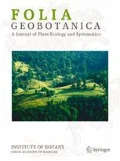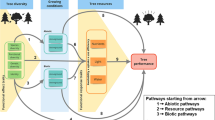Abstract
In a four-year removal experiment we investigated the effect of removing a dominant species (Nardus stricta), the litter layer and moss layer on species composition of established vegetation and on numbers and species composition of seedlings. The experiment was conducted in an oligotrophic wet meadow (Molinion with some features ofViolion caninae according to phytosociological classification). After four years of the experiment, the redundancy analysis (RDA) did not reveal any changes in the composition of the established plant community. Seedling numbers and their species composition, however, varied significantly both among treatments and over years. Whereas the differences between treatments were mainly in total seedling numbers, the years differed in both seedling numbers and relative representation of individual species. In particular,Myosotis nemorosa seedlings highly increased their abundance in a favourable year 1995 constituting one third of all the seedlings found, whereas in other years their abundance was between 4% and 10%. The effects of year and treatment were not additive (significant year × treatment interaction). This means that plots under different treatments are differently affected by climatic conditions of individual years. The greatest increase of seedling recruitment was observed in the plots with the moss layer removed. Microsites with high seedling recruitment persisted in the plots for no more than two years.
Why the established vegetation composition does not differ among treatments even after four years, despite the relatively pronounced and immediate response of seedlings? The number of species with regular seedling recruitment is limited. They are mostly perennials, and consequently, it might take even longer than four years before recruitment limitation affects the population size of established plants.
Similar content being viewed by others
References
Bakker J.P. &Berendse F. (1999): Constraints in the restoration of ecological diversity in grassland and heathland communities.Trends Ecol. Evol. 14: 63–68.
Bekker R.M., Verweij G.L., Smith R.E.N., Reine R., Bakker J.P. &Schneider S. (1997): Soil seed banks in European grasslands: does land use affect regeneration perspectives?J. Appl. Ecol. 34: 1293–1310.
Bell S.S., Robbins B.D. &Jensen S.L. (1999): Gap dynamics in a seagrass landscape.Ecosystems 2: 493–504.
Belsky J.A. (1992): Effects of grazing, competition, disturbance and fire on species composition and diversity in grassland communities.J. Veg. Sci. 3: 187–200.
Bobbink R. &Willems J.H. (1987): Increasing dominance ofBrachypodium pinnatum (L.)Beauv. in chalk grasslands — a threat to a species rich ecosystem.Biol. Conservation 40: 301–314.
Bosy J.L. &Reader R.J. (1995): Mechanisms underlying the suppression of forb seelding emergence by grass (Poa pratensis) litter.Funct. Ecol. 9: 635–639.
Brown R.T. (1967): Influence of naturally occurring compounds on germination and growth of Jack Pine.Ecology 48: 542–546.
Carson W.P. &Peterson C.J. (1990): The role of litter in an old-field community: impact of litter quantity in different seasons on plant species richness and abundance.Oecologia 85: 8–13.
Colling G., Matthies D. &Reckinger C. (2002): Population structure and establishment of the threatened long-lived perennialScorzonera humilis in relation to environment.J. Appl. Ecol. 39: 310–320.
Coulson S.J., Bullock J.M., Stevenson M.J. &Pywell R.F. (2001): Colonization of grassland by sown species: dispersal versus microsite limitation in responses to management.J. Appl. Ecol. 38: 204–216.
Delach A. &Kimmerer R.W. (2002): The effect ofPolytrichum piliferum on seed germination and establishment on iron mine tailings in New York.Bryologist 105: 249–255.
Diemer M., Oetiker K. &Billeter R. (2001): Abandonment alters community composition and canopy structure of Swiss calcareous fens.Appl. Veg. Sci. 4: 237–246.
During H.J. &van Tooren B.F. (1990): Bryophyte interactions with other plants.Bot. J. Linn. Soc. 104: 79–98.
Facelli J.M. &Facelli E. (1993): Interactions after death — plant litter controls priority effects in a successional plant community.Oecologia 95: 277–282.
Facelli J.M. &Pickett S.T.A. (1991): Plant litter: light interception and effects on an old field plant community.Ecology 72: 1024–1031.
Fischer M. &Matthies D. (1998): Experimental demography of the rareGentianella germanica: seed bank formation and microsite effects on seedling establishment.Ecography 21: 269–278.
Foster B.L. &Gross K.L. (1998): Species richness in a successional grassland: effects of nitrogen enrichment and plant litter.Ecology 79: 2593–2602.
Fowler N. (1981). Competition and coexistence in a North Carolina grassland. II. The effect of the experimental removal of species.J. Ecol. 69: 843–854.
Glenn S.M. &Collins S.L. (1993): Experimental analysis of patch dynamics in tallgrass prairie plant communities.J. Veg. Sci. 4: 157–162.
Goldberg D.E. &Barton A.M. (1992): Patterns and consequences of interspecific competition in natural communities — a review of field experiments with plants.Amer. Naturalist 139: 771–801.
Goldberg D.E. &Werner P.A. (1983): The effects of size of opening in vegetation and litter cover on seedling establishment of goldenrods (Solidago spp.).Oecologia 60: 149–155.
Grubb P.J. (1977): The maintenance of species richness in plant communities: the importance of the regeneration niche.Biol. Rev. 52: 107–145.
Hegland S.J., Van Leeuwen M. &Oostermeijer J.G.B. (2001): Population structure ofSalvia pratensis in relation to vegetation and management of Dutch dry floodplain grasslands.J. Appl. Ecol. 38: 1277–1289.
Herben T., Krahulec F., Hadincová V. &Pecháčková S. (1994): Is a grassland community composed of coexisting species with low and high spatial mobility.Folia Geobot. Phytotax. 29: 459–468.
Isselstein J., Tallowin J.R.B. &Smith R.E.N. (2002): Factors affecting seed germination and seedling establishment of fen-meadow species.Restor. Ecol. 10: 173–184.
Jensen K. &Meyer C. (2001): Effects of light competition and litter on the performance ofViola palustris and on species composition and diversity of an abandoned fen meadow.Pl. Ecol. 155: 169–181
Keizer P.J., van Tooren B.F. &During H.J. (1985): Effects of bryophytes on seedling emergence and establishment of short lived forbs in chalk grassland.J. Ecol. 73: 493–504.
Krahulec F. (1995): Species coexistence in temperate grasslands.Folia Geobot. Phytotax. 30: 113–116.
Křenová Z. &Lepš J. (1996): Regeneration of aGentiana pneumonanthe population in an oligotrophic wet meadow.J. Veg. Sci. 7: 107–112.
Kučera J. &Váňa J. (2003): Check- and Red List of bryophytes of the Czech Republic (2003).Preslia 75: 153–222.
Kull T. (1998): Fruit-set and recruitment in populations ofCypripedium calceolus L. in Estonia.Bot. J. Linn. Soc. 126: 27–38.
Lepš J. (1999): Nutrient status, disturbance and competition: an experimental test of relationships in a wet meadow copy.J. Veg. Sci. 10: 219–230.
Lepš J. &Šmilauer P. (2003):Multivariate analysis of ecological data using CANOCO. Cambridge University Press, Cambridge.
Marriott C.A., Fisher J.M., Hood K.J. &Smith M.A. (1997): Persistence and colonization of gaps in sown swards of grass and clover under different sward managements.Grass Forage Sci. 52: 156–166.
McConnaughay K.D.M. &Bazzaz F.A. (1987): The relationship between gap size and performance of several colonizing annuals.Ecology 68: 411–416.
Otsus M. &Zobel M. (2002): Small-scale turnover in a calcareous grassland, its pattern and components.J. Veg. Sci. 13: 199–206.
Rabotnov T.A. (1969): Plant regeneration from seed in meadows of the USSR.Herbage Abstr. 39: 269–277.
Rapp J.K. &Rabinowitz D. (1985): Colonization and establishment of Missouri prairie plants on artificial soil disturbances. 1. Dynamics of form and graminoid seedlings and shoots.Amer. J. Bot. 72: 1618–1628.
Roelofs J.G.M, Bobbink R., Brouwer E. &de Graaf M.C.C. (1996): Restoration ecology of aquatic and terrestrial vegetation on non-calcareous sandy soils in The Netherlands.Acta Bot. Neerl. 45: 517–541.
Rothmaler W. (1976):Exkursionsflora für die Gebiete der DDR und der BRD. Kritischer Band. Ed. 4. Volk und Wissen, Berlin.
Ryser P. (1993): Influences of neighbouring plants on seedling establishment in limestone grassland.J. Veg. Sci. 4: 195–202.
Ryser P., Langenauer R. &Gigon A. (1995). Species richness and vegetation structure in a limestone grassland after 15 years management with six biomass removal regimes.Folia Geobot. Phytotax. 30: 157–167.
Špačková I., Kotorová I. &Lepš J. (1998): Sensitivity of seedling recruitment to moss, litter and dominant removal in an oligotrophic wet meadow.Folia Geobot. 33: 17–30.
Stampfli A. (1992): Year-to-year changes in unfertilized meadows of great species richness detected by point quadrat analysis.Vegetatio 103: 125–132.
Suding K.N. &Goldberg D.E. (1999): Variation in the effects of vegetation and litter on recruitment across productivity gradients.J. Ecol. 87: 436–449.
ter Braak C.J.F. &Šmilauer P. (2002):CANOCO Reference manual and CanoDraw for Windows user’s guide: Software for Canonical Community Ordination (version 4.5). Microcomputer Power, Ithaca.
van Duren I.C., Strykstra R.J., Grootjans A.P., ter Hererdt G.N.J. &Pegtel D.M. (1998): A multidisciplinary evaluation of restoration measures in a degradedCirsio-Molinietum fen meadow.Appl. Veg. Sci. 1: 115–130.
van Tooren B.F. (1988): The fate of seeds after dispersal in chalk grassland: the role of the bryophyte layer.Oikos 53: 41–48.
van Tooren B.F. (1990): Effects of a bryophyte layer on the emergence of seedlings of chalk grassland species.Acta Oecol. 11: 155–163.
Willems J.H. (1983): Species composition and above ground phytomass in chalk grassland with different management.Vegetatio 52: 171–180.
Willems J.H., Peet R.K. &Bik L. (1993): Changes in chalk grassland structure and species richness resulting from selective nutrient additions.J. Veg. Sci. 4: 203–212.
Williams R.J. (1992): Gap dynamics in sub-alpine heathland and grassland vegetation in south-eastern Australia.J. Ecol. 80: 343–352.
Winn A.A. (1985): Effects of seed size and microsite on seedling emergence ofPrunella vulgaris in four habitats.J. Ecol. 73: 831–840.
Zamfir M. (2000): Effects of bryophytes and lichens on seedling emergence of alvar plants: evidence from greenhouse experiments.Oikos 88: 603–611.
Author information
Authors and Affiliations
Corresponding author
Rights and permissions
About this article
Cite this article
Špačková, I., Lepš, J. Variability of seedling recruitment under dominant, moss, and litter removal over four years. Folia Geobot 39, 41–55 (2004). https://doi.org/10.1007/BF02803263
Received:
Revised:
Accepted:
Issue Date:
DOI: https://doi.org/10.1007/BF02803263




